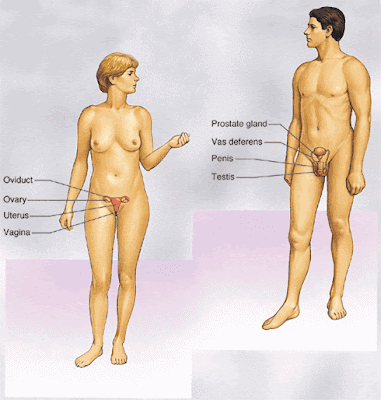Reproduction is an essential characteristic of living organisms, and functional male and female reproductive systems are necessary for individuals to reproduce. The male reproductive system produces sperm cells and can transfer them to the female. The female reproductive system produces oocytes and can receive sperm cells, one of which may unite with an oocyte.
Functions of the Reproductive System:
Male
1. Production of sperm cells
2. Sustaining and transfer of the sperm cells to the female
3. Production of male sex hormones
Female
1. Production of female sex cells
2. Reception of sperm cells from the male
3. Nurturing the development of and providing nourishment for the new individual
4. Production of female sex hormones
Meiosis is a special type of cell division necessary for sexual reproduction in eukaryotes. The cells produced by meiosis are gametes or spores. In many organisms, including all animals and land plants, gametes are called sperm and egg cells.
Meiosis begins with one diploid cell containing two copies of each chromosome—one from the organism's mother and one from its father—and produces four haploid cells containing one copy of each chromosome. Each of the resulting chromosomes in the gamete cells is a unique mixture of maternal and paternal DNA, resulting in offspring that are genetically distinct from either parent. This gives rise to genetic diversity in sexually reproducing populations. This genetic diversity can provide the variation of physical and behavioural attributes upon which natural selection can act. Origin and function of meiosis, the genetic diversity may be largely a by-product of the homologous recombination that is primarily employed for its DNA repair function during meiosis.
Male Reproductive Structures
Scrotum - a saclike structure containing the testes
Testes - small, ovoid organs, each 4-5 cm long, within the scrotum
Epididymis - the efferent ductules from each testes extend to a comma-shaped structure on the posterior side of the testes
Vas Deferens - duct of the epididymis
Urethra - male urethra is about 20 cm long and extends from the urinary bladder to the distal end of the penis
Penis - contains three columns of erectile tissue
Seminal Vesicles - a sac-shaped gland located next to the ampulla of the ductus deferens
Prostate Gland - about the size and shape of a walnut and surrounds the urethra and the two ejaculatory ducts at the base of the urinary bladder
Bulbourethral Glands - a pair of small, mucus-secreting glands located near the membranous part of the urethra
Semen - a mixture of sperm cells and secretions from the male reproductive glands
Female Reproductive Structures
Ovaries - are small organs about 2-3.5 cm long and 1-1.5 cm wide
Uterine Tubes - there are two uterine tubes, also called fallopian tubes or oviducts
Uterus - the size and shape of a medium-sized pear-about 7.5 cm long and 5 cm wide
Vagina - the female organ of copulation and receives the penis during intercourse
Perineum - the region between the vagina and the anus
Mammary Glands - modified sweat glands that produce milk
Here is a video on the process of fertilization
Wanna test your knowledge about reproductive system? Click the link below:
End of Chapter 24








